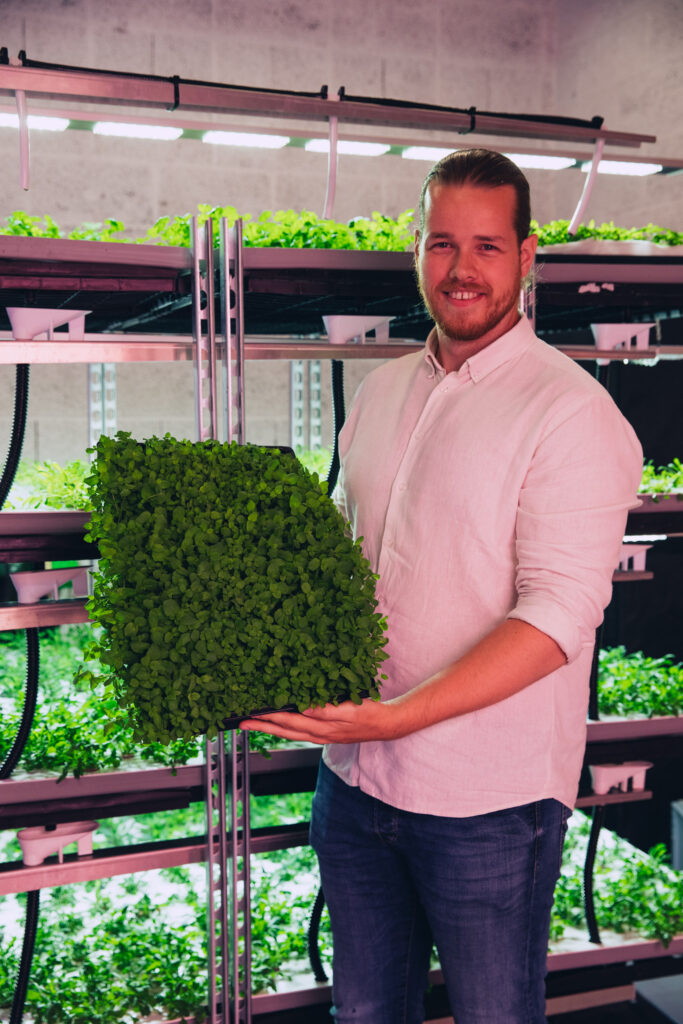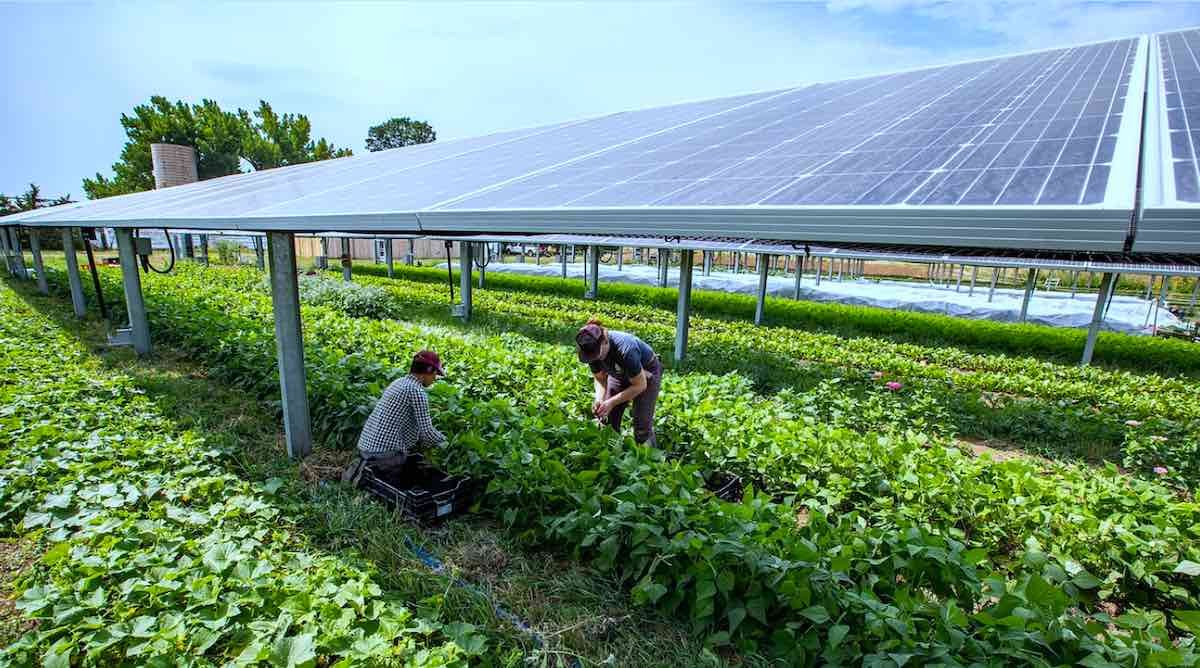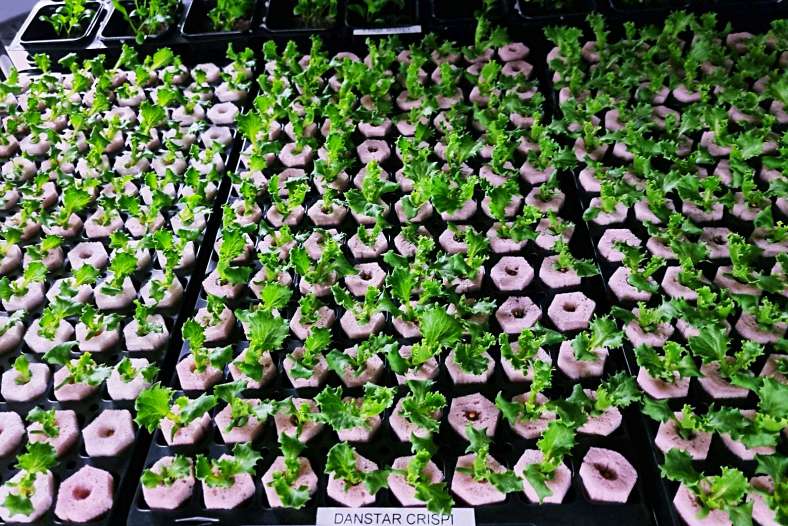Given the many advantages of vertical farming, and the growing advancement, the market for vertical farming is projected to grow from $4.16 billion in 2022 to $20.91 billion by 2029.
 The Potential for Renewable Energy in Vertical Farming
The Potential for Renewable Energy in Vertical Farming

Article from | Avisomo
Vertical farming and renewable energy: Both due to the growing population and the growing demands, Earth’s natural resources are on the brink of getting exhausted. With a minute-by-minute loss of 23 hectares of arable land and a human population that just reached 8 billion people, food shortage is an inevitable cause of worry for every nation. It is imperative to find new ways of producing food to satiate the hunger of the growing population, and this must be done in a sustainable way.
What is Vertical Farming?

Avisomo’s CEO Martin with a sample from our test facility.
Over the past few years, a lot of food producers have been exploring the opportunities in vertical farming for growing crops. Vertical farming is very different from conventional farming in the way that it is carried out indoors in vertical shelf systems without natural light or soil and with as little as 99% less water.
Additionally, vertical farming requires much less land area due to its vertical stacking. It does not depend on seasons for growing food since the conditions in the farm can be kept the same throughout the year.
This means that vertical farming can be done anywhere, irrespective of terrain and climatic conditions. This includes growing in or near cities, which also cuts down transportation costs and transport related emissions.
Another thing that makes vertical farming such an enticing prospect is the fact that food grown via this technique tends to have a longer shelf life due to local production and a lowered bacteria count, and is devoid of chemicals since there is no use of pesticides or chemical fertilizers.
Given the many advantages of vertical farming, and the growing advancement, the market for vertical farming is projected to grow from $4.16 billion in 2022 to $20.91 billion by 2029.
Vertical farming challenges
Despite all the benefits, vertical farming has a catch. Vertical farming is done indoors in extensive facilities, and utilizes LED lights to provide the plants with necessary lighting. LED lights which use a lot of energy. Adding to that, the energy consumed by other components s also substantial. This includes the machinery that regulates temperature, humidity and water circulation inside a vertical farm.
Vertical farming, no doubt, is an innovative technology geared at producing food on a large scale with less use of water, land, and chemicals. On paper, it might seem like a sustainable practice; however, vertical farming’s extensive use of electricity mostly comes from fossil energy sources. This results in an increased carbon footprint compared to other food production methods.
Renewable Energy and Vertical Farming
In order to develop vertical farming and the CEA industry – or “Controlled environment agriculture” – in the future, vertical farmers need to reduce costs related to both operations and energy. Thankfully, it looks like one way of reducing energy costs in the near future will also be a way to reduce vertical farming’s carbon footprint.
According to a new study by Rystad Energy, solar energy can become 10 times cheaper than electricity from gas based plants in the near future. This will make sustainable energy sources the most viable energy source for vertical farmers worldwide. Implications of this development include reductions of greenhouse gas emissions related to vertical farming, as well as potentially reduced production costs – leading to lower price points for vertically farmed greens.
Although renewable energy sources are still subjected to shortages and are not yet viable options all across the globe, the development is accelerating. There are already a variety of green power sources potential farmers have access to, that can offer a good proportion of the power needed for operations at a vertical farm. Also, sustainable industrial batteries, industrial hydrogen power cells and other emerging technologies will most likely be able to be utilized in a vertical farming context in the near future.
The incredible opportunities that renewable sources of energy bring for positive change would help the industry thrive and can also help support the overall energy transition. Also, the building of solar farms can actually contribute as necessary shelter for plants and animals in areas of extreme heat and droughts.

Jack’s Solar Farm – Photo by Werner Slocum: NREL. Borrowed from Agritecture
Beyond renewable energy
Apart from the use of renewable energy, optimizing other technologies in the farms will both reduce production cost and increasing yields. Building a farm that allows you to automate the production line, such as an Avisomo plant factory solution with Lowpad automation will greatly reduce production costs.
Also, if we develop and make even more energy efficient LED lights this will reduce costs related to both lighting and air conditioning even further, as more efficient lights emit less heat. Another way of reducing cost per unit produced is to optimize the density of plants per square meter to a maximum. More plants within the space, with the same amount of light. Here it is important to consider that plant growth is enabled through the amount of photons that hit the actual leaf – so a too high plant density might also be detrimental for growth. If you want to know more about the technicalities and potential for vertical farming, Avisomo can help you.
LED lights have come a long way over the last few years. After the EU banned Halogen lamps in 2018, the cost of LEDs has dropped by around 97%. And today they are much more efficient, consume less power, have a significantly longer lifespan and require lower maintenance than traditional lighting sources.
Takeaway

Nations and institutions worldwide are becoming more and more focused on finding solutions to the climate and nature crises. Following this we see an increased focus on finding alternative ways to produce food providing food safely with an efficient use of energy – such as vertical farming. The CEA industry is no doubt extremely innovative and has the potential to solve world hunger issues in the future.
Vertical farming still has its fair share of downsides, including increased use of energy and carbon footprint. It still has a lot of potential to reduce its emissions, provided technological developments in related sciences and industries such as renewable energy, LED lights, robotics and plant biology.
The combined development of these technologies might contribute to vertical farming becoming one of the primary sources of food production in the future, reducing humankinds’ dependence on fossil fuels and agricultural land – of which we have already reached peak availability.
The content & opinions in this article are the author’s and do not necessarily represent the views of AgriTechTomorrow
Comments (0)
This post does not have any comments. Be the first to leave a comment below.
Featured Product

